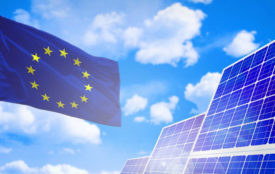Deep energy transformation needed by 2050 to limit rise in global temperature
Limiting the rise in global mean temperature to well below 2°C would require an energy transition of exceptional scope, depth and speed, according to an analysis by the International Energy Agency, including a doubling of annual average energy-related investments from current levels.
As recent IEA estimates show, global energy-related CO2 emissions stalled for a third straight year in 2016. This was the result of growing renewable power generation, switches from coal to natural gas, improvements in energy efficiency, as well as structural changes in the global economy. But in order to achieve longer-term climate goals, emissions need to peak before 2020 and fall by more than 70% below today’s levels by 2050, according to the IEA.
These findings are included in a report called “Perspectives for the Energy Transition – Investment Needs for a Low-Carbon Energy System,” which was prepared at the request of the German government to provide input for the G20 presidency. The analysis looks at what would be required from the energy sector to limit the global temperature rise to well below 2°C.
The IEA analysis finds that to achieve this climate objective a deep transformation of energy production and consumption needs to occur by 2050:
– Nearly 95% of electricity would need to be low-carbon by then, compared with about a third today, led by renewables;
– 7 out of every 10 new cars would need to be electric, compared with 1 in 100 today;
– The entire existing building stock would need to be retrofitted and the CO2 intensity of the industrial sector would need to drop by 80% below today’s levels;
– Fossil fuels, in particular natural gas, would still be needed in 2050, and would account for 40% of energy demand, around half of today’s level;
– $3.5 trillion in energy-sector investments would be needed on average each year until 2050, which is around twice current levels of investment.
These investment needs are unevenly spread. Energy-supply investments can remain at current levels until 2050, but would require a fundamental reorientation in spending: fossil-fuel investment would be lower and be largely offset by a 150% increase in renewable energy supply investment, as well as an increase in investment in nuclear power, carbon capture and storage, and in transmission and distribution grids.
Continued investment in fossil fuel would still be required to ensure security of supply. Natural gas would have an important role as a transition fuel and as a complement to variable renewable power through 2050. For oil, investment is particularly important since the decline from producing fields is larger than the expected decline in demand, and would need to be compensated.
The challenge is larger in end-use sectors such as industry, transport and buildings. In 2015, about $220 billion was spent on more efficient appliances, lighting, cars and trucks as well as industrial motors. Such investments would need to be 10 times higher by 2050. They would also need to include other areas, such as renewable energy used for heat production in the buildings and industrial sectors, electric cars and trucks. This sharp rise in investment will require policy support to ensure affordability for consumers.
Such a deep transformation of the energy sector would require ambitious policy measures, including a rapid phase out of fossil-fuel subsidies, rising CO2 prices, extensive electricity market reforms to integrate large shares of renewables, and stringent low-carbon and energy efficiency mandates. Such policies should also ensure energy remains affordable to the billions of people currently without access to energy. More global technology collaboration would also be required to facilitate low-carbon technology development and deployment. The IEA continues to support the energy transition through in-depth analysis, pragmatic policy advice and technology collaboration.
A link to the report can be found here.








